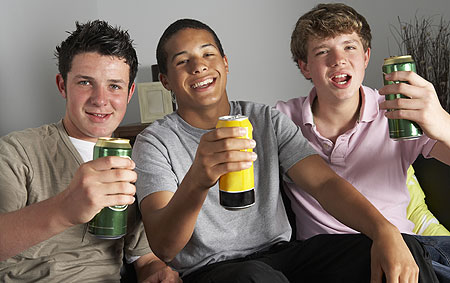
For Release: February 23, 2012
Contact: Donna Dubuc, Director of Marketing and Communications, (603) 653-3615 Donna.M.Dubuc@Dartmouth.edu
Alcohol in Movies Influences Young Teen Habits

According to researcher James Sargent, PhD, 'This study shows that exposure to movie depictions of alcohol predicts alcohol onset and progression to binge drinking during adolescence, and argues for greater attention to both smoking and drinking in movie ratings.'
Teens exposed to alcohol use in films are at risk for binge drinking and other risky behaviors, Cancer Center study shows.
Young teens who watch a lot of movies featuring alcohol are twice as likely to start drinking as their peers who watch relatively few such films, reveals new research from Dartmouth's Norris Cotton Cancer Center that is published in the online journal BMJ Open. Moreover, these teens are significantly more likely to progress to binge drinking, the study shows.
The findings prompt the researchers to suggest that Hollywood should adopt the same restrictions for alcohol product placement as it does for tobacco.
"Our research to date has emphasized the movie smoking-youth smoking link. But movie stars model other cancer causing behaviors, like alcohol use, an important cause of gastrointestinal cancers," commented James Sargent, MD, one of the study's authors and co-director of the Cancer Control Research Program at the Cancer Center. "This study shows that exposure to movie depictions of alcohol predicts alcohol onset and progression to binge drinking during adolescence, and argues for greater attention to both smoking and drinking in movie ratings."
Alcohol On-Screen
The conclusions of the study, titled "Comparing media and family predictors of alcohol use: a cohort study of US adolescents," are based on a representative sample of more than 6,500 U.S. teens between the ages of 10 and 14, who were regularly quizzed about their consumption of alcohol and potentially influential factors over the next two years. These factors included movie and marketing, the home environment, peer behavior, and personal rebelliousness.
The teens were asked which randomly selected 50 movies they had seen from among the top 100 U.S. box office hits in each of the preceding five years, plus 32 films grossing more than $15 million in the first quarter of 2003, the year of the first survey.
The number of seconds of on-screen alcohol use, including product placement, in each of these total 532 films was measured by trained coders. Given the movies they reported seeing, typical adolescents had seen an estimated 4.5 hours of on-screen alcohol use and many had seen in excess of eight hours.
More Movies = More Risky Behavior
After adjusting for factors likely to influence the results, teens who watched the most movies featuring alcohol were twice as likely to start drinking as those who watched the least. And they were 63percent more likely to progress to binge drinking, defined as consuming five or more drinks in a row. Alcohol in movies accounted for 28 percent of the proportion of teens who started drinking between surveys and for 20 percent of those who moved on to binge drinking.
Approximately one in 10 of the teens (11 percent) said they owned branded merchandise, such as a T-shirt or hat, with the name of a beer, wine, or spirit displayed on it. Nearly one in four (23 percent) said their parents drank alcohol at least once a week at home; 29 percent said they were able to obtain alcohol at home.
Over the course of the two years, the proportion of teens who started drinking alcohol more than doubled from 11 percent to 25 percent, while the proportion who began binge drinking tripled from four percent to 13 percent.
Exposure to alcohol in movies, owning branded merchandise, having friends who drank, and rebelliousness were associated with both taking up drinking and progression to binge drinking.
Parents who drank at home and availability of alcohol in the home were associated with taking up drinking, but not with progression to binge drinking.
Hollywood's Responsibility
The impact exerted by movies can be explained not only by characters who drink, but also by alcohol product placement, suggested the authors.
"Product placement in movies is forbidden for cigarettes in the USA, but is legal and commonplace for the alcohol industry, with half of Hollywood films containing at least one alcohol brand appearance, regardless of film rating," they write.
They point out that the depiction of smoking in movies has fallen since it became a public health issue and the subject of industry monitoring, and suggest that alcohol in movies "may deserve similar emphasis."
Hollywood has responsibilities further afield, given that half its movie revenues come from overseas, they add. "Like influenza, images in Hollywood movies begin in one region of the world then spread globally, where they may affect drinking behaviors of adolescents everywhere they are distributed," state the authors.
-DMS-